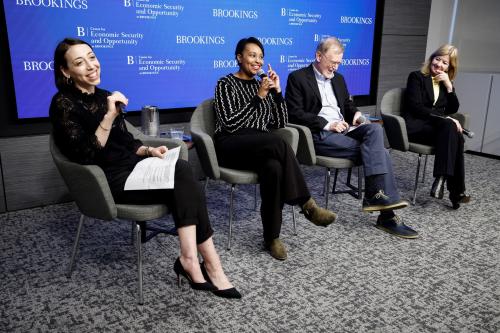This is a summary of an event held on July 31, 2024. You can watch full video of the event here.
On Wednesday, July 31, the Center for Economic Security and Opportunity (CESO) at Brookings hosted a webinar on the changing landscape of opportunity in America. The webinar focused on new research from Raj Chetty, Will Dobbie, Benjamin Goldman, Crystal Yang of Opportunity Insights, and Sonya Porter of the U.S. Census Bureau. Their research looked at data from 57 million children to show how opportunity is changing by race and class in America and identified the sociological forces that are driving these trends. The presentation was followed by a panel discussion moderated by Abigail Wozniak of the Federal Reserve Bank of Minneapolis.
The webinar began with an analysis of the geography of upward mobility in the United States and how historical factors including different rates of slavery have continued to influence economic mobility. This analysis motivated the group to ask: Can opportunity be changed? The answer is a resounding yes. The data, which uses tax information to analyze changes in outcomes for children born between 1978 and 1992, reveals that over that period, the Black-white gap in upward mobility has significantly narrowed, largely due to increased opportunities for Black children to escape poverty. On the other hand, the class gap among white children has widened, with greater disparities emerging between those from low- and high-income families.
The research also found a significant shift in the geography of economic opportunity across the United States. Historically, coastal regions offered greater pathways to upward mobility, especially for low-income families. However, the study found that these areas have experienced a decline in mobility, particularly affecting low-income white children. In contrast, regions like the Southeast and industrial Midwest have shown improvements in mobility for low-income Black children, highlighting the evolving regional dynamics in economic mobility.
Additionally, the report showed that these divergent trends in mobility by race and class were primarily driven by changes in the communities where children were raised. The study emphasized that childhood environments, measured by parental employment rates, played a crucial role in these shifts. Improvements in local employment conditions positively impacted the economic prospects of children, illustrating the importance of community-level factors in shaping economic mobility.
The study also highlighted the significant influence of children’s specific social networks on their economic outcomes. Data from Facebook showed that these networks, often segregated by race and class, are pivotal in shaping prospects and, if leveraged more intentionally, could potentially bring about greater opportunities for upward mobility across stratified groups. The findings indicate that children’s outcomes are profoundly affected by the economic status of parents within their immediate social circles. This segregation within social networks shows the critical role of social capital and interactions in determining access to opportunities, further emphasizing the importance of social environment on a child’s economic mobility trajectory. In essence, the study reveals that a child’s economic prospects are not only influenced by their family’s economic status, but also by the economic status of those they interact with on a regular basis.
The report emphasized that improvements in economic mobility are not a zero-sum game; benefits for one group do not come at the expense of another. Areas with better opportunities for children born to low-income Black families also tended to be those where mobility deteriorated the least for their white counterparts The discussion highlighted the importance of focusing on youth by investing in targeted job training and mentorship programs. Additionally, they stressed the need to target social communities rather than just neighborhoods, as social interactions are crucial in fostering economic opportunity. The implication for policy is that investing in social capital alongside financial and human capital is crucial in efforts to improve upward mobility, with the findings from the report emphasizing that such change can occur over relatively short time periods. This holistic approach can significantly improve economic opportunities and reduce disparities across racial and socioeconomic lines.
After the presentation on the findings of the report, the panel discussed main takeaways and their thoughts for further research, data investigation or linkage, and policy implications. Panelists included Robert Doar, President of American Enterprise Institute, Sherri Chisholm, Executive Director of Leading on Opportunity, Xavier de Souza Briggs, Senior Fellow in Brookings Metro, and Raj Chetty, Professor of Economics at Harvard University and Director of Opportunity Insights.
Sherri Chisholm began with comments about an important example of success when investing in economic mobility: the progress of Charlotte, NC. Charlotte, in a 2014 report from Opportunity Insights, was ranked 50th out of the 50 largest commuting zones on the ability for change in intergenerational mobility. In the new 2024 study, Charlotte moved into the third spot for change in intergenerational mobility. Chisholm discussed that this progress was encouragement to keep going and an affirmation to recognize the continual needs of the community.
Xavier de Souza Briggs echoed this positive takeaway, emphasizing that it is inspiring to see opportunity for advancement in economic mobility and that this research can set the record straight: that change in mobility is possible in a short amount of time. He also noted the power of data and the effectiveness of combining different sources to dig into patterns that can maximize the value of policy interventions.
Doar commented on the potential of big data, like the sources used in the Opportunity Insights report, to examine questions on social and economic mobility, namely: what can help the next generations? He called attention to the importance of a work-based safety net as a potential policy implication from the report’s findings, noting that parental employment seems to come with wide-ranging benefits for children, extending beyond simply financial resources.
Finally, Chetty answered further questions about his team’s report and its implications for policy. He acknowledged the inherent challenges in predicting economic mobility; researchers must wait for people to grow up, and it is always difficult to predict if current trends will continue, as the nature of social interactions may be changing with the advent of technology or there may be diverse long-term impacts on communities, such as from the recessions of 2008 and 2020. He noted the lack of distinction in trends for other race and ethnic groups in their mobility and pointed interested viewers to www.opportunityatlas.org where the data used for the analysis is available, including breakdowns by gender and marital status. Ultimately, Chetty reiterated an important takeaway: In the U.S., there are growing class gaps and shrinking racial gaps, and they are changing due to the social environment. He also re-emphasized that social mobility is not a zero-sum game, and that progress for one group does not come at the expense of another. In fact, he pointed out that we are all in this together, and that when people in our communities do better, we all have the potential to do better.
-
Acknowledgements and disclosures
The Brookings Institution is financed through the support of a diverse array of foundations, corporations, governments, individuals, as well as an endowment. A list of donors can be found in our annual reports published online here. The findings, interpretations, and conclusions in this report are solely those of its author(s) and are not influenced by any donation.
The Brookings Institution is committed to quality, independence, and impact.
We are supported by a diverse array of funders. In line with our values and policies, each Brookings publication represents the sole views of its author(s).








Commentary
The changing landscape of economic opportunity by race and class in America
New data and policy implications
August 8, 2024